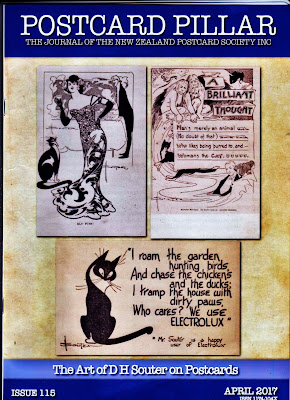Kiwis let cats out of the bag
A North Queensland researcher's highly illustrated , six page article on David Henry Souter (1862-1935) , renowned for drawings which often included slinky cats, is the cover story in the above New Zealand postcard magazine .
A black and white artist and writer, Souter was born in Aberdeen , Scotland , where, aged 12 , he was apprenticed to a house painter and signwriter . He studied at the South Kensington Art School , London , and was on the staff of a magazine called Bon Accord .
Off to Natal, South Africa , he went in 1871 , where he did drawings, occasional reporting , started a newspaper (which failed ) , married Jessie Swanson , set sail for Melbourne and ended up in Sydney .
On the staff of the Sydney Bulletin he became popular throughout the nation for his felines, in the art nouveau style, some of them with curvaceous women . It was claimed his famous Souter cats resulted from him cleaning up an ink blob on a drawing , turning it into a cat . Influential in artistic circles , he started a Brush Club for young artists under the age of 26, their work appraised by senior artists. From 1904-1911 he was art editor of Art and Architecture .
During World War One he was one of the many prominent artists who contributed to Dame Nellie Melba's fund raising book in aid of the Belgians, the full plate drawing of Souter with cats , above , one of the features. Melba explained that although she was Australian , as an artist , she had been born in Belgium , her first appearance in an opera had been at Brussels where she received a rousing reception from the warm-hearted Belgians.
The article says Souter's postcards covered many subjects , including marital strife, vacuum cleaners . An Australian Native Bare ( Bear ) , was one of a few Australian postcards subjected to censorship . It and another , A Bally Dancer, were the subject of a New Zealand court case in which a shopkeeper was prosecuted for selling indecent cards , under the Offensive Publications Act 1892, deemed to be clearly libidinous and calculated to have a pernicious influence , especially on the minds of boys and girls .
The above WWl postcard depicting an Aussie Digger cat in a slouch hat attacking a German sausage dog was popular at the time . The article in the New Zealand magazine includes a 1907 photograph of Souter sitting with a group of people , one a woman in a large hat , on large rugs spread out on the floor , at the Society of Artists' Selection Committee , saying cheers over a few bottles , artwork hanging in the background .
Some of his cat studies were used in Bush Babs (1933), a collection of nonsense rhymes he wrote for his children and later illustrated for publication. His cats were featured on Royal Doulton chinaware. The Australian Dictionary of Biography says that Souter was among the first to draw Australian posters and , with Norman Lindsay , to design bookplates It goes on to say in September 1907 Souter's operetta, The Grey Kimona (1902), was staged in Adelaide by Clyde Meynell and John Gunn. Involved with Alfred Hill's Sydney Repertory Theatre Society, Souter produced two plays in 1914 and wrote librettos for light operas including Hill's Rajah of Shivapore.
A selection of his full-page war cartoons for the Stock Journal were reprinted in 1915. Not least of his many triumphs were two comic strips, 'Sharkbait Sam' and 'Weary Willie and the Count de Main', drawn for the Sydney Sunday Sun in 1921: frame for frame, their inventiveness and composition were remarkable. By 1928 Souter was literary editor of Country Life...





